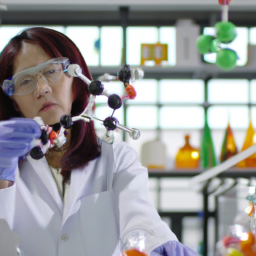Recent advancements in structural biology have shed light on the intricate world of proteins, particularly in the study of heliorhodopsin, a newly identified member of the rhodopsin family. This article delves into the recent author correction published in Nature regarding the crystal structure of heliorhodopsin, highlighting its significance, the implications of the correction, and the broader context of rhodopsin research. Heliorhodopsin is a type of photoreceptive protein that has garnered attention due to its unique structural features and potential applications in various fields, including optogenetics and synthetic biology. The original study, which reported the crystal structure of heliorhodopsin, provided valuable insights into its function and mechanism. However, the recent correction emphasizes the importance of accuracy in scientific reporting, particularly in structural biology, where minute details can significantly alter the interpretation of a proteins function. In my experience, the process of refining structural data is crucial for advancing our understanding of protein dynamics. The correction in the heliorhodopsin study serves as a reminder of the meticulous nature of scientific research. As observed in many cases, initial findings can be subject to revision as new data emerges or as errors are identified in the crystallographic analysis. This iterative process is a fundamental aspect of scientific inquiry, ensuring that our understanding evolves with new evidence. The correction itself addresses specific discrepancies in the original data presentation, which could potentially lead to misinterpretations of the proteins functional properties. According to official reports from the research team, the adjustments made in the corrected version clarify the arrangement of certain molecular components within the heliorhodopsin structure. These changes are not merely cosmetic; they have implications for how researchers understand the proteins interaction with light and its subsequent signaling pathways. Experts agree that accurate structural representation is vital for the development of targeted therapies and biotechnological applications. The heliorhodopsin structure, once accurately depicted, can provide a framework for designing experiments that explore its role in cellular processes. Research confirms that proteins like heliorhodopsin can be harnessed for optogenetic tools, which allow scientists to control cellular activity with light. This capability has profound implications for neuroscience and other fields where precise control over cellular functions is desired. The significance of heliorhodopsin extends beyond its immediate applications. As a member of the rhodopsin family, it contributes to our understanding of the evolutionary adaptations of photoreceptive proteins. Studies show that the diversity within this family reflects the various environmental pressures organisms face, leading to unique adaptations in light perception. By examining heliorhodopsin, researchers can gain insights into the evolutionary trajectory of sensory proteins and their functional diversification. Moreover, the correction highlights the collaborative nature of scientific research. The original authors, along with peer reviewers and the editorial team, play a crucial role in ensuring the integrity of published findings. Regulatory agencies report that transparency in the correction process fosters trust in scientific literature, allowing the community to build on a solid foundation of verified data. This collaborative effort is essential in maintaining the credibility of research, especially in fast-evolving fields like structural biology. As the field progresses, it is essential to consider the implications of heliorhodopsin research on future studies. The corrected structure not only enhances our understanding of this specific protein but also opens avenues for exploring related proteins within the rhodopsin family. Industry experts note that the knowledge gained from heliorhodopsin can inform the design of novel proteins with tailored functions, potentially leading to breakthroughs in medicine and biotechnology. In conclusion, the recent author correction regarding the crystal structure of heliorhodopsin serves as a critical reminder of the importance of accuracy and transparency in scientific research. The iterative nature of scientific inquiry ensures that our understanding of complex biological systems continues to evolve. As researchers build upon the corrected findings, the implications for both fundamental biology and applied sciences are profound. The study of heliorhodopsin not only enriches our understanding of photoreceptive proteins but also exemplifies the collaborative spirit of the scientific community in striving for excellence and accuracy. Moving forward, it will be fascinating to observe how these insights translate into practical applications and further our understanding of sensory biology.
TRENDING NOW
WORLD
Global Messaging Trends: Can Local Apps Like Arattai Overtake Giants?
44% 🔥
POLITICS
Accusations fly over whether Republicans or Democrats 'own' shutdown
35% 🔥
POLITICS
Rep. Mike Haridopolos, R-Fla., talks about the government shutdown
34% 🔥
POLITICS
What happens now that the government has shut down. And, a pricing deal with Pfi...
26% 🔥
POLITICS
Married, but no connection: Reality of silent divorces in Indian homes
31% 🔥
POLITICS
Netanyahu's apology to Qatar, phone on Trump's lap: A telling White House photo
38% 🔥
MOST READ
SPORTS
Week 5 NFL odds, lines, betting picks, spreads: 2025 predictions: Model backs Sa...
55% 🔥
SPORTS
Predicting every undefeated college football team's first loss: Will anyone beat...
36% 🔥
SPORTS
Tigers Lefty Tarik Skubal Deserves Second Straight AL Cy Young Award
54% 🔥
SPORTS
Jets Get Official Braelon Allen Injury Diagnosis
61% 🔥
SPORTS
Gill: India won't be 'looking for any easy options' against West Indies
49% 🔥
SPORTS
Phil Mickelson takes a jibe at golf during friendly banter with ex-LIV Golf CEO’...
39% 🔥

